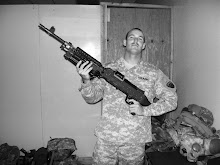September 2-6
Our trip to Crane Naval Base was pretty uneventful. The trip was to get the newer soldier in the unit familiarized with the basic procedures and duties of an Ammunition Specialist. The very basic duties have to do with handling a few different types of ammunition, storage, distribution, demilitarization, and basic maintenance. When handling ammo, we use a few different kinds of forklifts, from 10,000 pound all-terrain to the 3,000 pound warehouse Hysters like you would see at Costco. The Hysters are fairly easy to drive, as they are small and move quickly around tighter areas. Most of the underground and berm magazines are crammed with ammo, so Hysters really help out. The all-terrain forks are used for the outdoor magazines and storage areas, as they can lift more and have offroad capabilities. The 10k and 6k forks are a little more difficult to drive, as they are a lot bigger and harder to control. They can reach higher top speeds, but don’t usually move fast with loads on the forks. It takes a lot of hours behind the wheel of any fork to be able to master its capabilities and be able to use the right amount of force or finesse. After being in the cab for a while, I’ve seen a lot of different situations that require using the forks for things they aren’t intended for, and only experience helps with the solution to most of these problems. Forks can be used to push, pull, dig up, or smash things as needed, but you’ll only be able to do it right if you’ve seen it or done it yourself. Anyway, the ammunition at Crane is controlled entirely by civilians, so that was new for some of the newer soldiers also.
Most soldiers on this trip were placed on teams that were paired with civilian teams, and they learned from their leaders on both sides. The soldiers with experience were placed with civilian teams and went straight to work, while the other teams were walked through and introduced to the operations. I got paired with a few different civilian teams, and it was nice to get away from the group for a while and knock out some real work. Over the course of this trip I loaded over a thousand pallets of .50cal, 2.5inch rockets, 155mm propellant charges, and some other Navy missiles onto various platforms. Some of the loads were into shipping containers (or connexes), others were on flatbed truck trailers, and some were even into railcars. The railcars were my favorite. They are pretty tough to load, space is tight and depending on the load being carried it can get dangerous. I hadn’t loaded a railcar in a long time, so it felt good when I knocked the first few down. After that it just turned into a blur as we loaded each railcar all the way through the day. The team I was with that day had their stuff together, and we watched quite a few railcars go out full and come in empty. I liked working by myself too, nobody from the group complaining or wanting to take breaks. I skipped lunch and didn’t even notice. I was pretty tired after 14 hours of loading that day, and I slept pretty well, even in the crappy barracks they put us in.
Most everyone got some good training, but a few soldiers were paired with some civilians teams that weren’t so receptive as mine. I understand why, it’s almost as if we were in the way. The civilians had to stop their normal routine and explain it to a bunch of new jacks and let them try it out. Anyone that does this job every day for a while is going to be faster than a bunch of newbies that have never loaded a railcar, let alone driven a forklift. I was pretty lucky I fell into a good rhythm quick, as I hadn’t been in a forklift for over a year before that.
We arrived back at Camp Atterbury on the 6th of September to some great news: we had a 10 day pass to go on leave coming up! The pass length would allow us to come home and enjoy our last few days in the states in a comfortable environment.
-Mac
Subscribe to:
Post Comments (Atom)

No comments:
Post a Comment